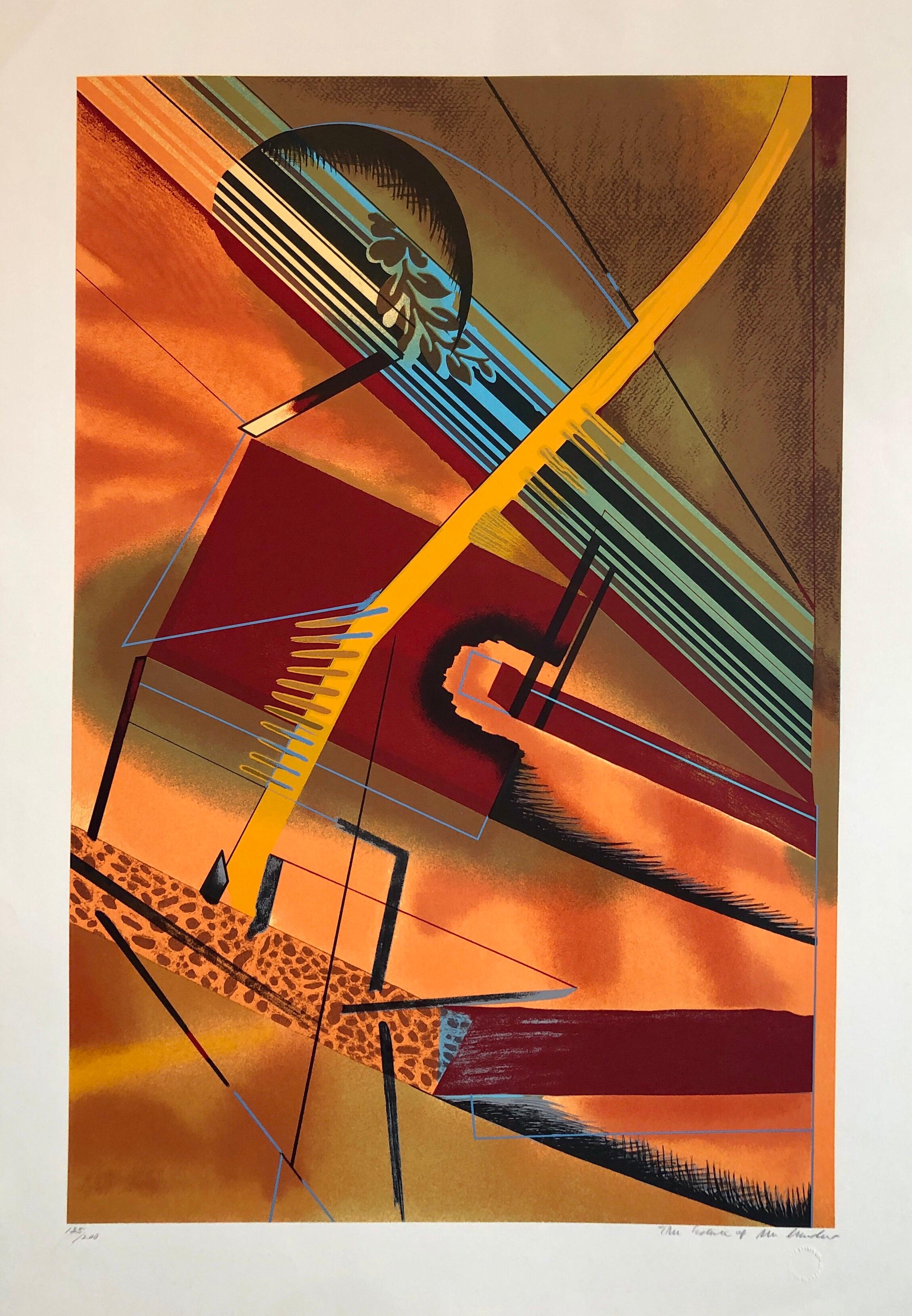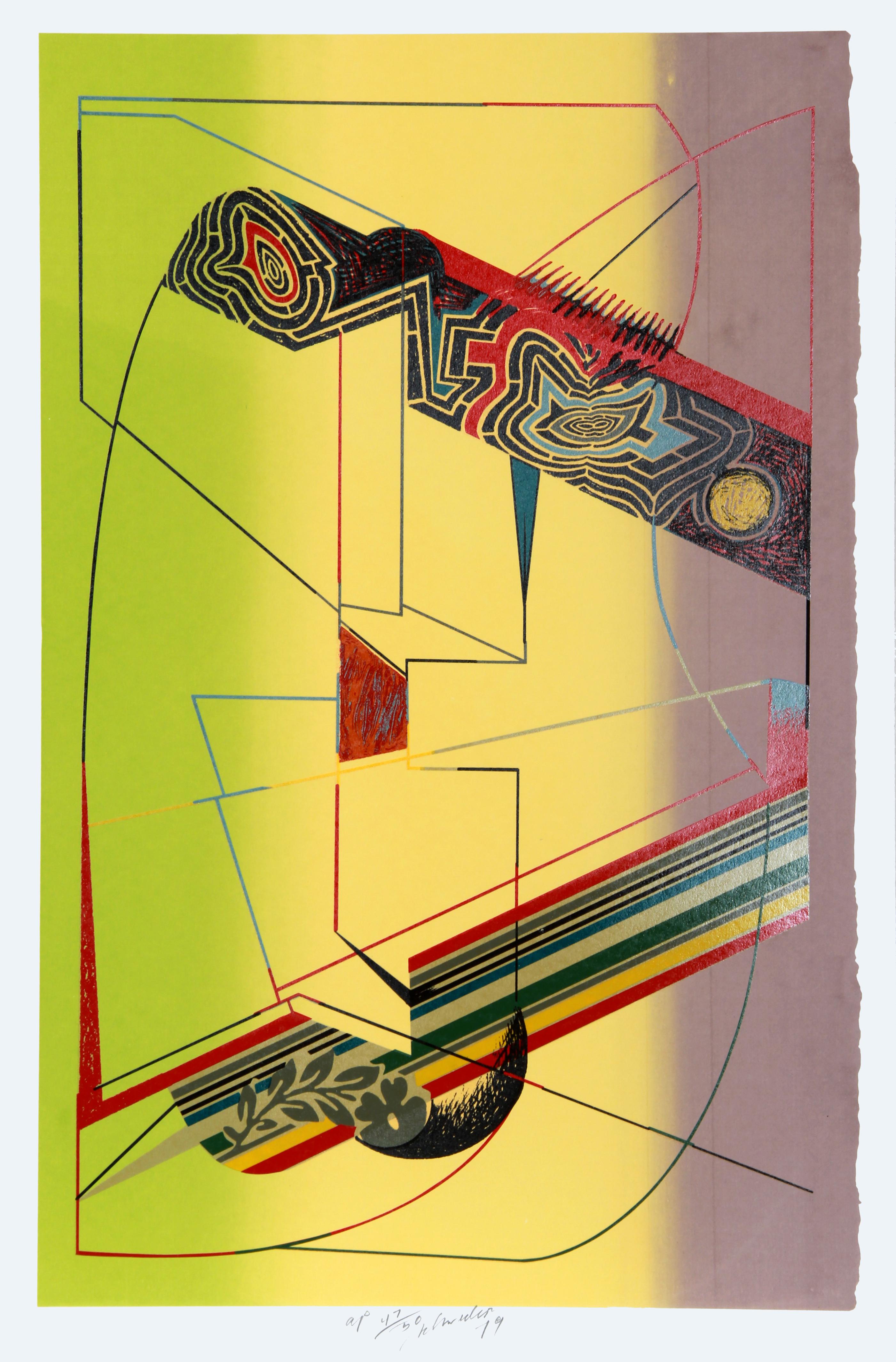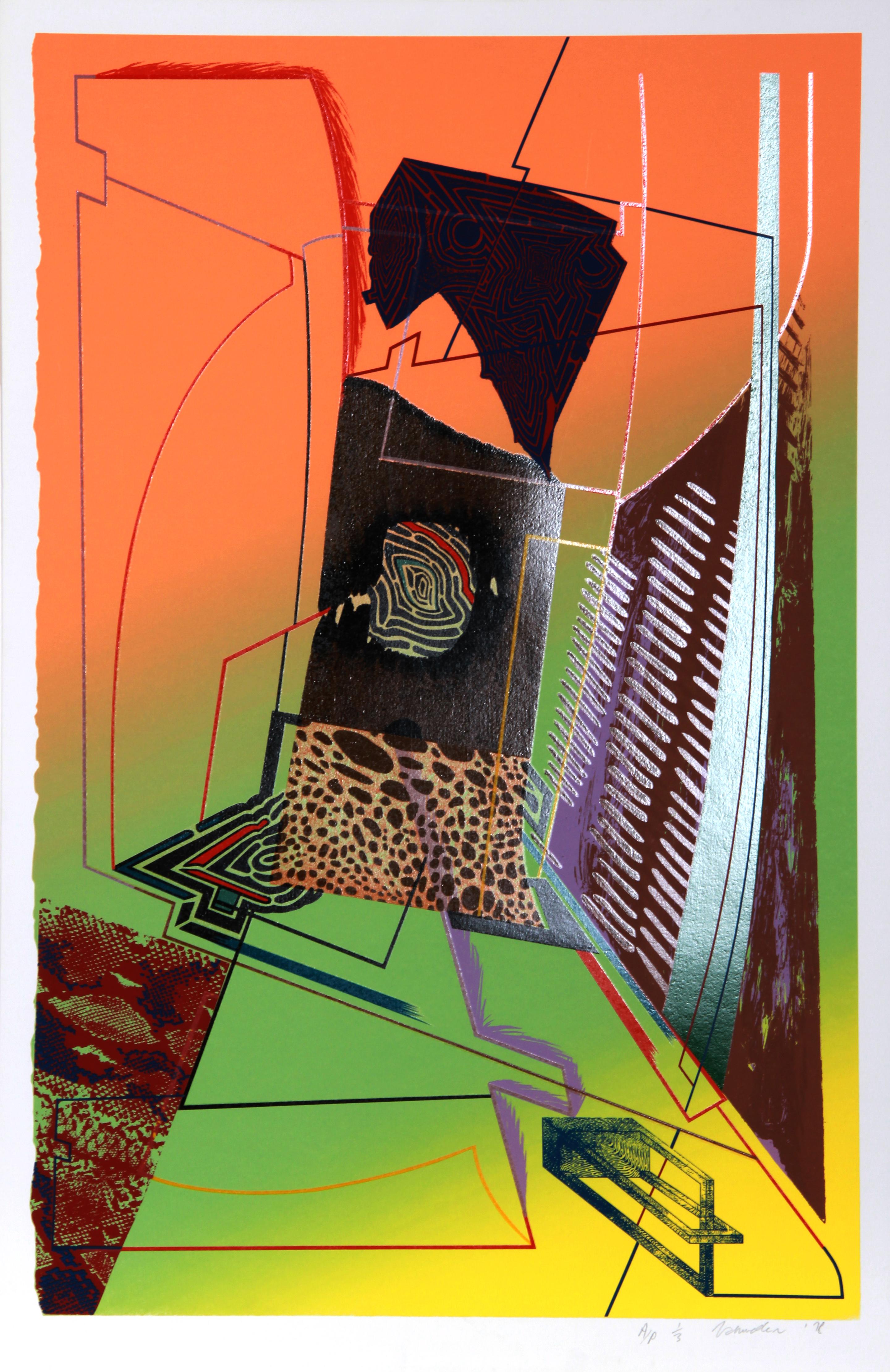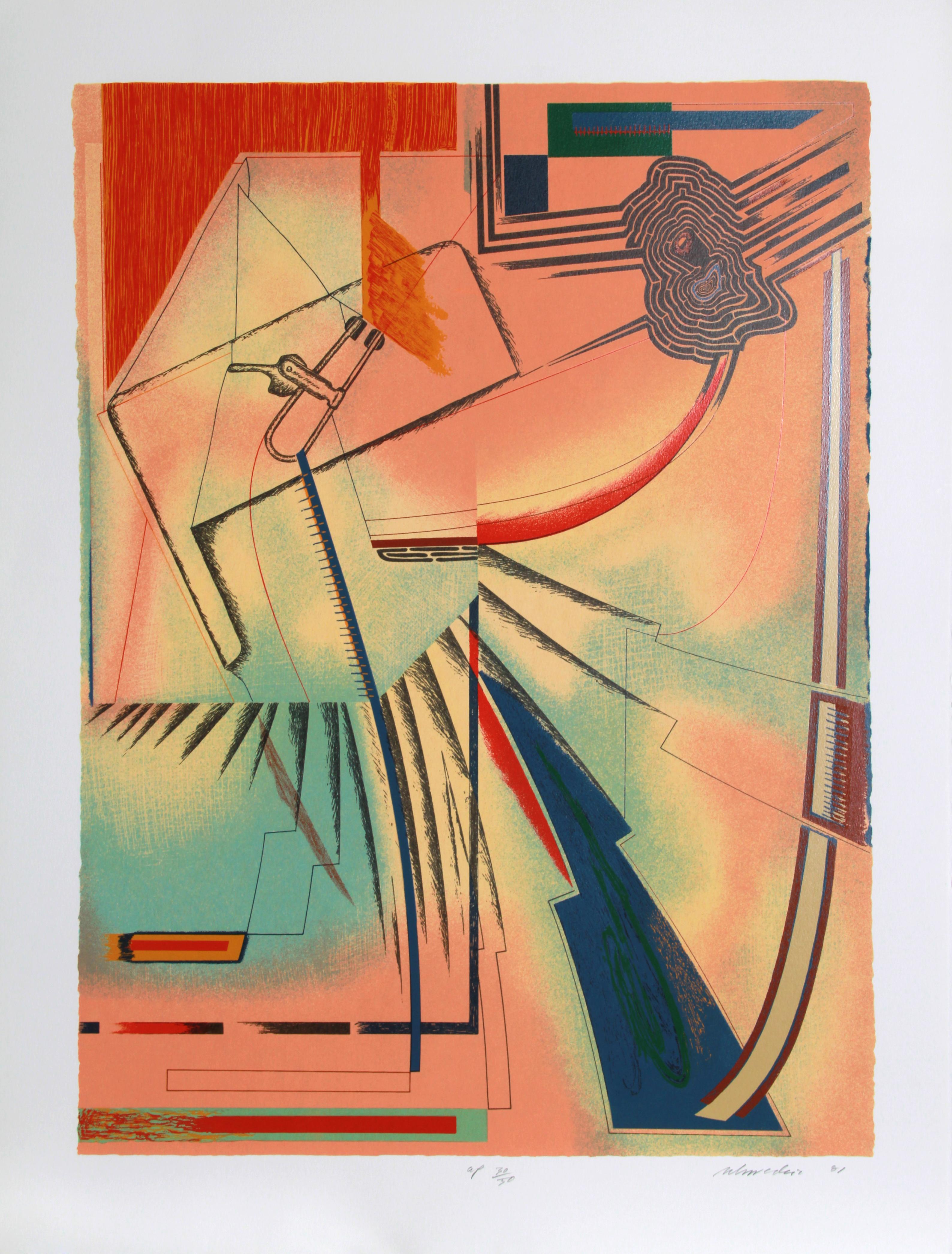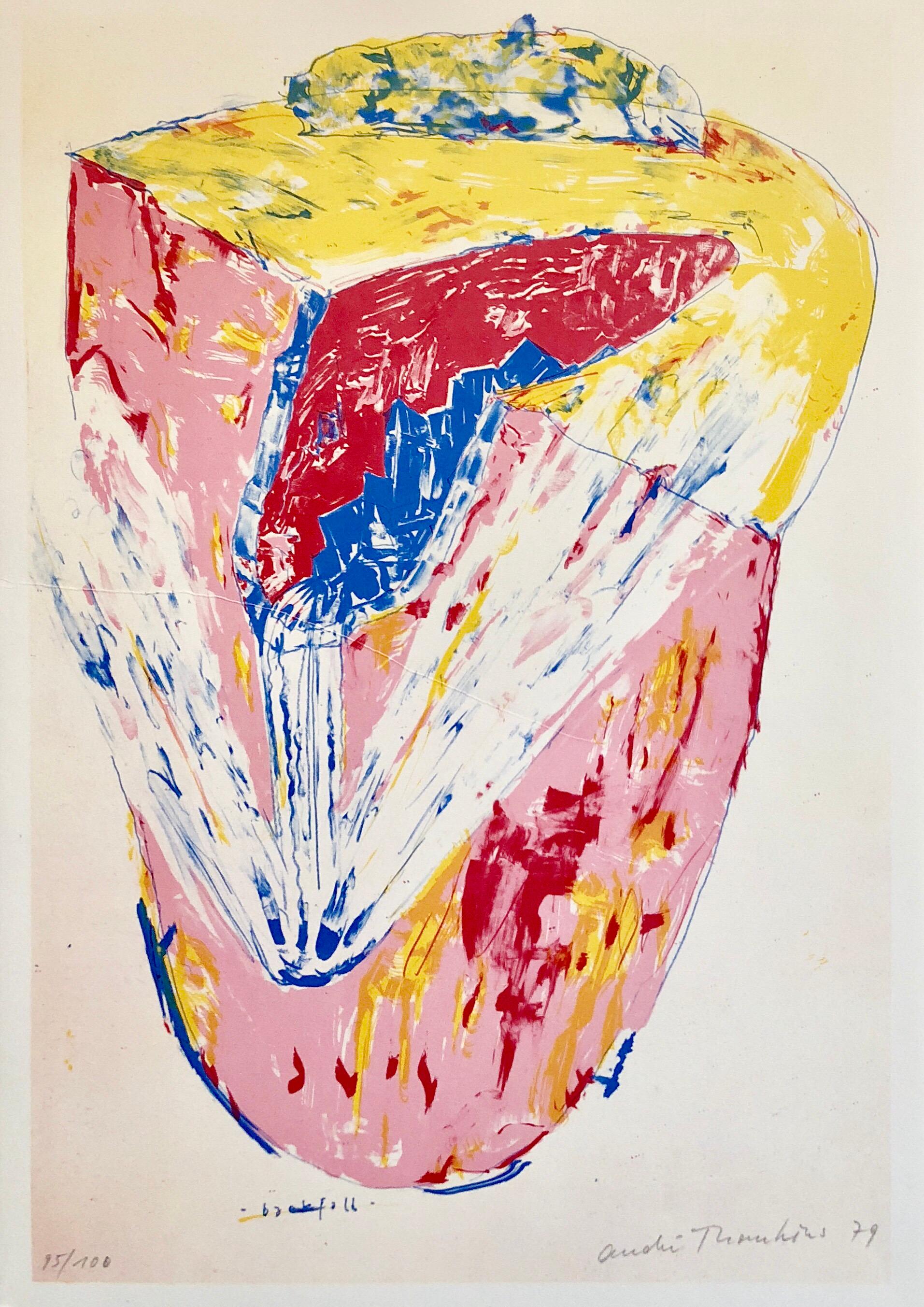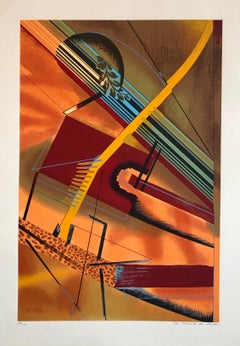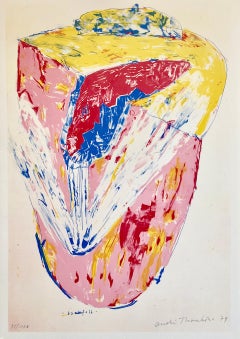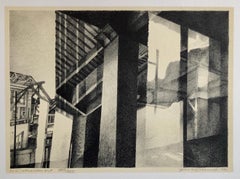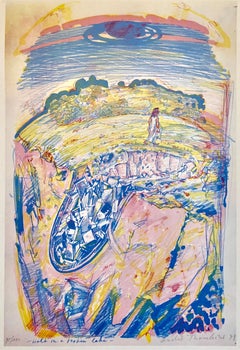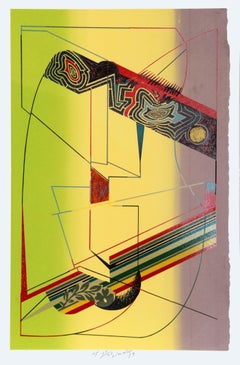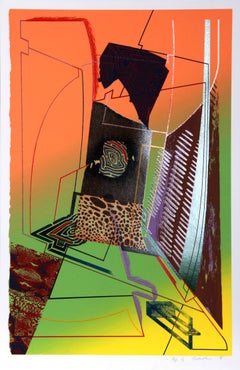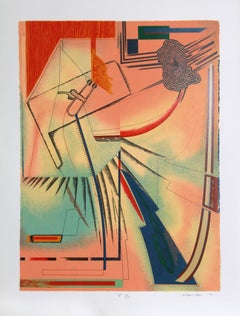Items Similar to Surrealist Architectural Landscape "Fall for it" 1970s Chicago Modernist
Want more images or videos?
Request additional images or videos from the seller
1 of 10
William SchwedlerSurrealist Architectural Landscape "Fall for it" 1970s Chicago Modernist1978
1978
$750
£566
€647.99
CA$1,057.75
A$1,161.28
CHF 605.84
MX$14,053.06
NOK 7,593.27
SEK 7,154.85
DKK 4,837.07
About the Item
This serigraph has never been framed.
Chicago born Modernist. Showed at Andrew Crispo Gallery and Tibor de Nagy Gallery. Schwedler could not help but be influenced by the local artistic milieu particularly with those contemporaries and friends who formed the Hairy Who in the Mid - 1960's
Schwedler's Paintings from the beginning to his young end were ripe with a surreal, abstract poetry filled with references to landscapes, architecture, texture (cracked), line (broken,chopped, and Pulled to pieces), and delicate, but voluptuous color. Studying at the Art institute of Chicago with his friends Cynthia Carlson, Jim Nutt, Art Green, and Karl Wirsum, taking in the grains, textures, spaces, and elevated structures of this oh-so-American city.
part of an artistic circle that included Italo Scanga, Ernest Silva, Lee Jaffe, and Donald Gill. Franz Schulze (Chicago Imagist Art, 1972 ) has observed of Schwedler, "... his work took on its fundamental character during his chicago years. if the city did not form him it was surely the place where his formative experiences occurred ...".
Befitting an artist born and trained in Chicago, Schwedler was much affected by funk and given to jokey titles and weird imagery, but his colors, which seem as if they are veiled by fine black gauze, don't fit with the jokes. He worked mainly geometrically, alluding to figures occasionally in paint and collage, and he sometimes accentuated shapes by building them up in Rhoplex. Toward the end, he was painting on undulating bands of plywood mounted to stand a couple of feet off the wall. This is Surrealism that projects a very unhumorous sense of matter decomposing, in the Ivan Albright tradition. He showed in 1974 at the inaugural show of Alessandra Gallery with Curt Barnes, Charles Garabedian, Art Green, Michael Hurson, Jane Kaufman, Italo Scanga and Wm. Schwedler
- Creator:William Schwedler (1942 - 1982, American)
- Creation Year:1978
- Dimensions:Height: 39 in (99.06 cm)Width: 26.5 in (67.31 cm)
- Medium:
- Movement & Style:
- Period:
- Condition:minor wear. never framed.
- Gallery Location:Surfside, FL
- Reference Number:1stDibs: LU38213484862
About the Seller
4.9
Platinum Seller
Premium sellers with a 4.7+ rating and 24-hour response times
Established in 1995
1stDibs seller since 2014
1,810 sales on 1stDibs
Typical response time: 1 hour
- ShippingRetrieving quote...Shipping from: Surfside, FL
- Return Policy
Authenticity Guarantee
In the unlikely event there’s an issue with an item’s authenticity, contact us within 1 year for a full refund. DetailsMoney-Back Guarantee
If your item is not as described, is damaged in transit, or does not arrive, contact us within 7 days for a full refund. Details24-Hour Cancellation
You have a 24-hour grace period in which to reconsider your purchase, with no questions asked.Vetted Professional Sellers
Our world-class sellers must adhere to strict standards for service and quality, maintaining the integrity of our listings.Price-Match Guarantee
If you find that a seller listed the same item for a lower price elsewhere, we’ll match it.Trusted Global Delivery
Our best-in-class carrier network provides specialized shipping options worldwide, including custom delivery.More From This Seller
View AllSurrealist Architectural Landscape Silkscreen 1970s Chicago Modernist Lithograph
By William Schwedler
Located in Surfside, FL
Orange, Turquoise, Red, Surrealist abstract.
This serigraph has never been framed. It is pencil signed by hand "the estate of Wm Schwedler" and numbered in pencil from the limited ed...
Category
1970s American Modern Abstract Prints
Materials
Screen
1970s Modernist Swiss Colorful Surrealism Signed Dada Lithograph Andre Thomkins
By André Thomkins
Located in Surfside, FL
This one is titled "Backfall" It depicts what looks like an abstract Chihuly sculpture or lithograph in pink, blue, red and yellow colors.
Published by Edition Hansjörg Mayer, Stuttgart They published concrete poetry and art books by Mark Boyle, Richard Hamilton, Dorothy Iannone, John Latham, Tom Phillips, Dieter Roth, André Thompkins and Emmett Williams, to name just a few.
André Thomkins (1930 - 1985) was a Swiss painter, illustrator, and poet. He attended art-school, taught by Max von Moos, 1947 – 1949 and the Académie de la Grande Chaumière, Paris, France, 1950. From 1952, he lived in Germany and taught at the Kunstakademie Düsseldorf between 1971 and 1973.
Thomkins painted and drew ironic and fantastic pictures influenced by surrealism and dadaism. Together with Dieter Roth and Daniel Spoerri he prepared works of Eat Art. He also was a writer of palindromes. His friends and collaborators included Daniel Spoerri, Dieter Roth, George Brecht, Richard Hamilton and Karl Gerstner, Thomkins gained a reputation as an ‘artist’s artist’, and is considered one of the most important Swiss artists of the second half of the twentieth century.He died in 1985.
His work is currently represented by Hauser & Wirth Zurich, Switzerland.
Select group exhibitions:
2018
Kunsthalle Krems, 'Pablo Picasso. Arshile Gorky, Andy Warhol. Sculptures and Works on Paper. Hubert Looser Collection', Krems, Austria
2017
Kunsthandel Wolfgang Werner, 'Martin Barré, Karl Otto Götz, Ernst Wilhelm Nay, André Thomkins',
Berlin, Germany
2013
Fabian & Claude Walter Galerie, 'Schweizer Avantgarde Kunst nach 1940', Zurich, Switzerland
2009
The Modern Institute, 'Thomas Houseago, Dieter Roth, Andre Thomkins', Glasgow, England
Museum of Modern Art, 'Compass in Hand: Selections from the Judith Rothschild Collection', NYC
2004
Kunsthandel Wolfgang Werner, 'Arman, Baumeister, Götz, Graubner, Tàpies, Thomkins', Berlin,
Germany
1994
Kunstmuseum Solothurn, 'Eine Schenkung. Grafik von Eduardo Chillida, Antoni Tàpies, Alexander Calder, Jean Dubuffet, Ben Nicholson, Giacometti, Tinguely, Thomkins', Solothurn, Switzerland
1992
Galerie Littmann, Tinguely zu Ehren. A Tribute to Jean Tinguely. Hommage à Tinguely, Basel,
1988
Museum Ludwig, 'Uebrigens sterben immer die anderen. Marcel Duchamp und die Avantgarde seit
1950', Cologne, Germany
1987
Aargauer Kunsthaus, 'Otto Grimm. Marc-Antoine Fehr. Christoph Gredinger', Aarau, Switzerland
Cercle Municipal, 'Art contemporain suisse. Collection de la Banque du Gothard', Luxembourg,
1985
Centre national d'art et de culture Georges Pompidou, 'Livres d'artistes', Paris, France
Rathaus, 'Claude Sandoz – Hans Schärer...
Category
1970s Dada Figurative Prints
Materials
Lithograph, Offset
Chicago Scene Modernist Architectural Lithograph, Nevada Artist
Located in Surfside, FL
Jim McCormick was born in Chicago in 1936. He attended the University of Tulsa where he received a bachelor’s degree in art in 1958, then a M.A. in paint...
Category
1980s American Modern Abstract Prints
Materials
Lithograph
1970s Modernist Swiss Colorful Surrealism Signed Dada Lithograph Andre Thomkins
By André Thomkins
Located in Surfside, FL
This one is titled "Walk in a Broken Lake" and depicts a surreal figure of a robed woman walking in an abstract landscape in yellow, green, red and blue with a Salvador Dali esque quality about it.
Published by Edition Hansjörg Mayer, Stuttgart They published concrete poetry and art books by Mark Boyle, Richard Hamilton, Dorothy Iannone, John Latham, Tom Phillips, Dieter Roth, André Thompkins and Emmett Williams, to name just a few.
André Thomkins (1930 - 1985) was a Swiss painter, illustrator, and poet. He attended art-school, taught by Max von Moos, 1947 – 1949 and the Académie de la Grande Chaumière, Paris, France, 1950. From 1952, he lived in Germany and taught at the Kunstakademie Düsseldorf between 1971 and 1973.
Thomkins painted and drew ironic and fantastic pictures influenced by surrealism and dadaism. Together with Dieter Roth and Daniel Spoerri he prepared works of Eat Art. He also was a writer of palindromes. His friends and collaborators included Daniel Spoerri, Dieter Roth, George Brecht, Richard Hamilton and Karl Gerstner, Thomkins gained a reputation as an ‘artist’s artist’, and is considered one of the most important Swiss artists of the second half of the twentieth century.He died in 1985.
His work is currently represented by Hauser & Wirth Zurich, Switzerland.
Select group exhibitions:
2018
Kunsthalle Krems, 'Pablo Picasso. Arshile Gorky, Andy Warhol. Sculptures and Works on Paper. Hubert Looser Collection', Krems, Austria
2017
Kunsthandel Wolfgang Werner, 'Martin Barré, Karl Otto Götz, Ernst Wilhelm Nay, André Thomkins',
Berlin, Germany
2013
Fabian & Claude Walter Galerie, 'Schweizer Avantgarde Kunst nach 1940', Zurich, Switzerland
2009
The Modern Institute, 'Thomas Houseago, Dieter Roth, Andre Thomkins', Glasgow, England
Museum of Modern Art, 'Compass in Hand: Selections from the Judith Rothschild Collection', NYC
2004
Kunsthandel Wolfgang Werner, 'Arman, Baumeister, Götz, Graubner, Tàpies, Thomkins', Berlin,
Germany
1994
Kunstmuseum Solothurn, 'Eine Schenkung. Grafik von Eduardo Chillida, Antoni Tàpies, Alexander Calder, Jean Dubuffet, Ben Nicholson, Giacometti, Tinguely, Thomkins', Solothurn, Switzerland
1992
Galerie Littmann, Tinguely zu Ehren. A Tribute to Jean Tinguely. Hommage à Tinguely, Basel,
1988
Museum Ludwig, 'Uebrigens sterben immer die anderen. Marcel Duchamp und die Avantgarde seit
1950', Cologne, Germany
1987
Aargauer Kunsthaus, 'Otto Grimm. Marc-Antoine Fehr. Christoph Gredinger', Aarau, Switzerland
Cercle Municipal, 'Art contemporain suisse. Collection de la Banque du Gothard', Luxembourg,
1985
Centre national d'art et de culture Georges Pompidou, 'Livres d'artistes', Paris, France
Rathaus, 'Claude Sandoz – Hans Schärer...
Category
1970s Surrealist Figurative Prints
Materials
Lithograph, Offset
1970s Modernist Swiss Colorful Surrealism Signed Dada Lithograph Andre Thomkins
By André Thomkins
Located in Surfside, FL
This one is titled "Little Animals" and depicts drawings of small animals over an abstract forest background in green, red and tan with a quali...
Category
1970s Surrealist Figurative Prints
Materials
Lithograph, Offset
Italian Abstract Aquatint Collage Lithograph Print Eugenio Carmi 80s Memphis Era
By Eugenio Carmi
Located in Surfside, FL
Genre: Modern, Modernist
Subject: Abstract
Medium: Print, Aquatint
Hand signed dated 1988, limited edition
Surface: Paper
Country: Italy
Dimensions: 26" x 20" approximately
Eugenio ...
Category
1980s Post-Modern Abstract Prints
Materials
Aquatint
You May Also Like
Fall For It II, Abstract Screenprint by William Schwedler
By William Schwedler
Located in Long Island City, NY
Artist: William Schwedler, American (1942 - 1982)
Title: Fall For It II
Year: 1979
Medium: Screenprint, Signed and numbered in pencil
Edition: AP 50
Size: 39 x 26 in. (99.06 ...
Category
1970s Abstract Abstract Prints
Materials
Screen
First Things First, Abstract Geometric Screenprint by William Schwedler
By William Schwedler
Located in Long Island City, NY
This abstract composition by William Schwedler includes several geometric forms and shapes that are placed alongside straight, angled lines.
First Things First
Artist: William Schw...
Category
1970s Abstract Abstract Prints
Materials
Screen
Dead Give Away, Abstract Expressionist Screenprint by William Schwedler
By William Schwedler
Located in Long Island City, NY
Along with several other of his abstract geometric prints, William Schwedler's fusion of tropical, bright background colors with the simulation of animal print along one of the major...
Category
1970s Abstract Abstract Prints
Materials
Screen
Piece by Piece, Screenprint by William Schwedler
By William Schwedler
Located in Long Island City, NY
This abstract composition by William Schwedler includes several geometric forms and shapes that are placed alongside straight, angled lines.
Piece by Piece
Artist: William Schwedle...
Category
1980s Abstract Abstract Prints
Materials
Screen
Urban landscape - Etching by Jean Michel Folon - 1970s
By Jean Michel Folon
Located in Roma, IT
Urban landscape is a modern artwork realized by the belgian illustratorJean-Michel Folon (1934- 2005).
Original etching and aquatint.
Handsigned and numbered on the lower margin ...
Category
1950s Contemporary More Prints
Materials
Etching
Jasha Green, "Untitled 29, " Lithograph, circa 1976
By Jasha Green
Located in Long Island City, NY
This lithograph was created by American artist Jasha Green (1923-2006). Known for his abstract expressionist vision, some of his prints also show his appreciation for op art and surrealism...
Category
1970s Abstract Abstract Prints
Materials
Lithograph
